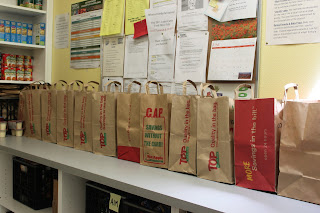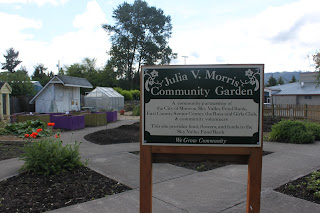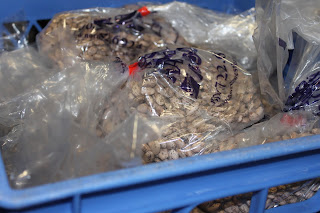Friday, June 24, 2011
Food Research and Actions Center Updates
Action Needed: Contact the White House (President Obama and Vice President Biden) and your Senators to urge them to protect SNAP and other safety net programs during the debt ceiling negotiations. Key decisions are happening now!
Background: As you know, Vice President Biden and a bi-partisan group of Congressional leaders have been negotiating a debt-ceiling/deficit reduction plan and hope to reach an agreement by July 1. News reports indicate those talks may be moving to a more select group with the President. At the top of the agenda is securing $4 trillion in savings from program cuts over the next 10 or 12 years. Whether or not revenues will be part of the final plan is also in play. Anti-hunger advocates must demand that the negotiators follow a key principle included in the National Commission on Fiscal Responsibility and Reform’s plan (Bowles-Simpson): protect programs for low-income families and individuals, like SNAP, and make sure that the deficit reduction is achieved in a way that does not increase poverty.
Any plan that does not include a commitment to protect low-income people, and new revenues, will result in a massive loss of services for our nation’s most vulnerable, as in the recently passed House (Ryan) budget.
Action Needed:
1. Contact the White House (President Obama and Vice President Biden). Call toll-free 1-888-245-0215
Message: Any deficit reduction plan must protect programs for low-income families and individuals, such as SNAP, and must also include new revenues. The plan should reduce poverty and help the disadvantaged, even as it attempts to shrink the deficit. Low-income assistance programs, like SNAP/Food Stamps, must be exempt from any caps and automatic across-the-board cuts which could be triggered when budget targets or fiscal restraint rules are missed or violated.
2. Call your Senators. Call your Senators and deliver the same message. Toll-free number: 1-888-907-1485, thanks to AFSCME.
Please take these actions immediately to demonstrate your support for responsible long-term deficit reduction through a combination of revenue increases and spending cuts that do not harm the poor and vulnerable.
*Information provided by FRAC
Friday, June 17, 2011
Free Summer Meals!

The school year is ending and summer meal programs will be starting soon! OSPI trained more than 170 program sponsors across the state for summer 2011. WithinReach partners with OSPI to publicize summer meal programs all through the summer. Right now we have information about 575 sites across Washington and more will be added over the next few weeks:
* Find 2011 summer meal sites with the Summer Meals Search Tool by clicking here
* Call the multilingual Family Food Hotline 1-888-4-FOOD-WA (1-888-436-6392)
Thursday, June 16, 2011
House Passes Harmful FY2012 Agriculture Appropriations Bill
On June 16, the House passed its FY2012 Agriculture Appropriations spending bill, H.R. 2112, by a vote of 217 to 203, concluding three days of unusually contentious debate triggered by the radical and destructive provisions in the bill. The bill’s overall allocation for FY2012 ($17.250 billion) is $5 billion (23%) below the President’s FY2012 request and approximately $3 billion (14%) below FY2011 levels. The bill includes cuts to the Special Supplemental Nutrition Program for Women, Infants and Children (WIC), the Commodity Supplemental Food Program (CSFP), The Emergency Food Assistance Program (TEFAP) and the McGovern-Dole International Food for Education and Child Nutrition Program. The bill’s accompanying Committee Report (pdf) tries to inflict additional harm.
Details on FY2012 House Agriculture Appropriations bill:
Note: These figures do not reflect an additional 78/100 of 1 (one) percent across-the-board cut that was included in an amendment that was attached to the bill. Check the FRAC website for final House-passed funding levels.
* Funds WIC at $6.048 billion. This figure includes $147 million provided by Rep. Rosa DeLauro’s (D-CT) amendment at full Committee consideration. This additional funding was stripped out on the House floor, and then reinserted by an offset that reduced all accounts in the Ag Approps bill by a 0.78 percent across-the-board cut. Even with the additional $147 million, the program is not expected to serve all those who are eligible. WIC was funded at $6.7 billion in FY2011.
* Funds the Commodity Supplemental Food Program (CSFP) at $138.5 million, $38 million less than the President’s FY2012 budget request and below the FY2011 level of $176.8 million.
* Caps TEFAP mandatory commodity funding (funding level set in Farm Bill) at $200 million, a $51 million cut from FY2011.
* Funds TEFAP Storage and Distribution (Administration) at $37.5 million, a $12 million cut from FY2011.
* Provides $1.5 million for the Congressional Hunger Center Emerson/Leland Fellows Program (funded in FY2010 at $3 million).
* Cuts $2 billion from the SNAP reserve fund provided in the President’s FY2012 budget, annual funding that is provided in the event that participation is greater than expected. No cuts are made to caseloads or benefit levels, including the remaining benefit boost contained in the ARRA bill, as previously amended.
* Funds WIC Farmers’ Market nutrition program at $20 million (includes $5 million in additional funding provided in a successful House floor amendment).
* McGovern-Dole International Food for Education and Child Nutrition Programs was funded at $180 million (10% below FY2011 and FY2012).
- Information provided by Food Research and Action Center
Wednesday, June 15, 2011
Rebuilding Together Seattle
 Are your facilities in need of some repairs? Do your clients need help making their home a safe place to live? Rebuilding Together Seattle is an amazing organization that helps non-profits and home owners improve their surroundings. Operating in more than 865 cities and towns in all 50 states, Rebuilding Together rehabilitated more than 7,800 homes and non-profit facilities in 2000 with the volunteer power of 237,000 men, women and children.
Are your facilities in need of some repairs? Do your clients need help making their home a safe place to live? Rebuilding Together Seattle is an amazing organization that helps non-profits and home owners improve their surroundings. Operating in more than 865 cities and towns in all 50 states, Rebuilding Together rehabilitated more than 7,800 homes and non-profit facilities in 2000 with the volunteer power of 237,000 men, women and children.Rebuilding Together Seattle provides donated repair services for homeowners in need so they can continue to live independently in warmth and safety.
Who They Are
Rebuilding Together Seattle was established in 1989 and is part of the national Rebuilding Together organization (formerly Christmas in April). We are a volunteer, charitable group and repair or rebuild homes at no cost to low-income homeowners, particularly those who are elderly, disabled or families with children.
RTS is governed by a volunteer Board of Directors and is staffed by an Executive Director and Program Administrator. RTS also offers an internship program to select college students in Seattle.
History and National Impact
Our affiliate is part of the national Rebuilding Together organization that has over 200 affiliates in 50 states. The organization was first known as Christmas in April, which began in Midland, Texas in 1973 when a group of volunteers decided to devote one day a year to repairing dilapidated homes in their community. The project developed into the nation’s leading volunteer home repair organization.
Across the country, every year, the last Saturday in April is National Rebuilding Day. Over 300,000 volunteers rehabilitate 9,000 homes and non-profit facilities. The work takes place in nearly 900 cities and towns, delivering a market value of $97 million!
How They Do It
All work is done by volunteers at no cost to the homeowner. Corporations, individuals and other groups sponsor or donate funds or materials to cover project and operational costs.
Tuesday, June 14, 2011
Spokane Street Music Week
Head downtown for Spokane Street Music Week
*Information Provided by 2nd Harvest.
Monday, June 6, 2011
Meet Our Members- Snohomish Community Food Bank

If you want to encounter a group of cheery and selfless people, make a trip out to the Snohomish Community Food Bank. Last week Washington Food Coalition was able to make a trip up to Snohomish and was warmly welcomed into the Food Bank. Each volunteer greeted me with an outstretched arm and a smile. It felt as though I was entering the home of a close family.
With a herd of friendly and dedicated volunteers, the SCFB distributes Tuesdays from 3-7pm and Fridays from 10-3pm (open for donations 5 days a week). As stated on their website, “This life-giving resource exists to provide basic foods and services to qualified recipients in a caring, dignified and humane manner. The Food Bank serves every qualified applicant within the boundaries of the Snohomish School District and is supported solely through donations and community volunteers who solicit, manage and distribute it’s reserves. Since 1985, local citizens have screened beneficiaries, collected and distributed food, and provided social services on a weekly basis.” SCFB prides itself on giving clients a dignified shopping experience, complete with shopping cards and the ability to make decisions as they walk through the food bank. Volunteers oversee each station and greet clients as they make their way through the store. Numbers on the front of the shopping carts indicate the size of each family to inform volunteers how much to provide each person. All food is presented in an appealing and accessible manner to make the process as enjoyable as possible. SCFB is also able to provide baby food, formula and diapers to families with small children thanks to a local Kiwanis Club. In the back of the food bank you can also find shelves of food for “special diets” such as diabetes.
During the recent “Stamp Out Hunger” food drive, SCFB had a record number of donations and completely filled their storage area, reaching above the heads of most volunteers (pictured below). Donations totaled 24,542 pounds!
Elizabeth Grant, Director of SCFB, beamed as she explained one of their newer programs to feed homeless teens. Every Friday bags of food are dropped off at local high school for specific students who have been reported as homeless or “couch surfing”. Some of these teens are pregnant or mothers and so the weekend food supply is altered to meet their specific needs. According to SCFB
“This year, through the generosity of Morgan Stanley and Food Lifeline, we are able to run this program on its own. Program Manager, Dana Gibson collects the food, packs it into two grocery sacks
per person and delivers them to the AIM High School for weekend meals for 10
– 12 students. Six students have babies, so this funding provides the infant care,
as well”. SCFB also provides backpacks filled with school supplies to elementary aged children each fall.

The Snohomish Community Food Bank is continually looking for ways to improve their operations and engage their community in feeding the hungry.
*Information provided by SCFB website and Elizabeth Grant, Director of SCFB.
Friday, June 3, 2011
Meet Our Members- Sky Valley Food Bank
 The Sky Valley Food Bank is yet another example of a supportive community coming around the hungry and ensuring food is available several times a week. Open 3 mornings a week, they serve around 1,100 households per month, as well as 20 home deliveries every 2 weeks. According to their website, "There are approximately 70 volunteers who donate their time working at the food bank and picking up food seven days a week. Volunteers are the "Heart" of our program!" Neil Watkins, Executive Director of SVFB, explained that his volunteers take great pride in their job and have served consistently for several years (totally 16,241 hours of services last year). Neil encourages and appreciates his volunteers through monthly barbecues and by keeping them well informed on what is happening around the food bank.
The Sky Valley Food Bank is yet another example of a supportive community coming around the hungry and ensuring food is available several times a week. Open 3 mornings a week, they serve around 1,100 households per month, as well as 20 home deliveries every 2 weeks. According to their website, "There are approximately 70 volunteers who donate their time working at the food bank and picking up food seven days a week. Volunteers are the "Heart" of our program!" Neil Watkins, Executive Director of SVFB, explained that his volunteers take great pride in their job and have served consistently for several years (totally 16,241 hours of services last year). Neil encourages and appreciates his volunteers through monthly barbecues and by keeping them well informed on what is happening around the food bank.

Neil uses his connections with the community well and receives donations from churches, clubs, schools and businesses. The Food Bank is so well loved by their city that they pay only $1 a year to rent their building. Several grants have allowed the Food Bank to start a program providing school supplies to children in August. This upcoming Fall will mark the seconds year they will be able to offer kids a backpack filled with supplies needed for school.

Tucked next to the Food Bank is a successful and completely volunteer run garden. This beautiful gardens produces 1,100 pounds of food each summer that goes directly to the clients. The gardens also has small plots of land that can be rented by community members, bringing a small amount of revenue back to the Food Bank.




The Sky Valley Food Bank is a life giving organization that is constantly looking ahead to better serve the needy in their community.

*A Special Thanks to Neil Watkins for his time and information.
Thursday, June 2, 2011
Meet our Members- West Seattle Food Bank
 In the heart of West Seattle you will find a successful and driven group of people running the West Seattle Food Bank. Open three days a week for clients, they serve approximately 700 West Seattle families that rely heavily on the generosity of the community and the services WSFB provides. Every Tuesday and Thursday morning, along with Wednesday evenings, the Food Bank opens their doors and welcomes a diverse group of people to shop in their warehouse. With the help of their dedicated volunteers, the WSFB provided 1,040,000 pounds of food in 2010.
In the heart of West Seattle you will find a successful and driven group of people running the West Seattle Food Bank. Open three days a week for clients, they serve approximately 700 West Seattle families that rely heavily on the generosity of the community and the services WSFB provides. Every Tuesday and Thursday morning, along with Wednesday evenings, the Food Bank opens their doors and welcomes a diverse group of people to shop in their warehouse. With the help of their dedicated volunteers, the WSFB provided 1,040,000 pounds of food in 2010.
Besides regular weekly hours, the Food Bank also does home visits for those unable to make it all the way to the food bank. Last year the completed 37,936 house hold visits to the hungry in the West Seattle area. About 150 bags are delivered weekly by volunteers. Below is a picture of a what a home visit bag might look like or what a client might receive during Food Bank off hours.

The WSFB works diligently to serve has an increasing amount of children walking through their doors, currently 37% of the population they serve. Families are provided monthly supplies of baby food and diapers in thanks to the WSFB's relationship with West Side Baby, an organization that distributes used children's items. This relationship also allows WSFB to take orders of supplies families may need (toys, cribs, car seats) and make them available for their clients.



Thanks to the help of local grocery stores, dedicated volunteers, West Side Baby, and a hard working staff, the WSFB successfully feeds the hungry in their neighborhood.

* A special thanks to Fran Yeatts, Executive Director of WSFB, for sharing her time and information with WFC
* West Side Baby website: http://www.westsidebaby.org/
MyPlate to replace MyPyramid
This morning in a high-energy press conference, First Lady Michelle Obama, USDA Secretary of Agriculture Tom Vilsack and Surgeon General Regina Benjamin announced that MyPyramid will be replaced with MyPlate. The release of the new icon is designed to make it easier for families to know how to eat healthfully. The release of this icon begins a massive effort among every food-related federal agency to promote the recommendations in the USDA/DHHS 2010 Dietary Guidelines for Americans.
MyPlate is a dinner plate with color-coded, wedge-shaped sections Fruits, Grains, Proteins, and Vegetables. Half of the plate is Fruits and Vegetables. Overlapping the plate is a blue circle for Dairy. To see the new icon, go to www.ChooseMyPlate.gov
Key points about the Dairy group, based on the 2010 Dietary Guidelines, are:
-
Dairy is an essential part of a nutritious diet.
-
The Dairy group includes milk, yogurt, cheese, lactose-free milk, and fortified soy beverage.
-
To meet the recommended three cups of Dairy foods, most Americans should add one or more serving each day. Americans currently consume just under two servings.
-
Moving to low-fat or fat-free milk is one of the six key behaviors that USDA/DHHS state are most important to change.
-
Dairy foods provide three of the four “nutrients of public health concern.” Americans do not get enough calcium, vitamin D, and potassium (all in Dairy foods); they also do not get enough fiber.
-
Adequate Dairy group intake is associated with improved bone health, and decreased risk for cardiovascular disease, Type 2 diabetes, and hypertension.
Health Professionals and nutrition educators can read about getting started with MyPlate and can find the archived MyPyramid at www.choosemyplate.gov/
*Information provided from Washington State Dairy Council*








